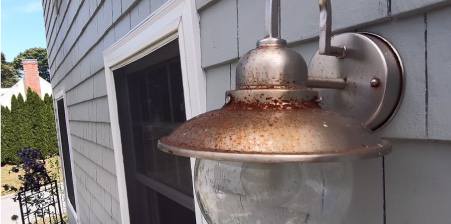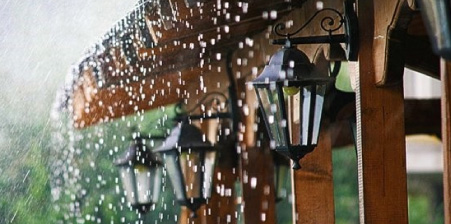Your knowledge of ratings will help you get the most value from your lights.
When a light fixture is going to be installed in a place where it will be in direct contact with rain or snow or in areas with constant or direct exposure to water, select a wet-rated model. Some of these locations include lights that are outside directly against the ground, outside on a building with no structural cover or enclosure, or indoors inside a shower.
Damp-rated fixtures should be installed in places like an indoor pool area, utility room, bathroom vanities and ceiling outside the shower, over a kitchen sink and in other places like this where light fixtures are not in direct water contact, but may be exposed to steam or collect condensation. Damp-rated fixtures could also be used outdoors in covered or overhang areas where the lights will be installed under a structure and not in direct contact with rain or snow. For example; an open-air fully covered deck or a garage overhang.
The main reason to use damp and wet-rated light fixtures is safety. You want to make sure your lighting fixtures are rated for the environments you would like to install them. Choosing the correct lighting for a space isn’t as simple as finding a fixture that looks good to you. It also has to function properly under the environmental conditions for where it is being installed. Even when a light fixture is rated correctly for the space, it still needs to be installed correctly to ensure that it is safe. After you consider all of this, it doesn’t mean the light fixture won’t rust within a year or two. The material and finish of a light fixture is important to get the most value from your light. The image below is a wet-rated lighting fixture that began rusting after one (1) year. We should point out it was not purchased at a lighting showroom rather a big box store. To avoid this from happening to you, come see a lighting specialist at one of our lighting showrooms and check out our blog on outdoor lighting to learn more on the various materials used on outdoor lighting fixtures to increase the life of the product. Click Here

Lights depend on electrical currents for power. When water
comes in contact with electricity, water can cause a fire. That’s why it’s
important to prevent moisture from building up inside the electrical parts of a
light fixture. When a lighting fixture is wet-rated, it not only uses specific coating
around the wire but also the fixture itself is constructed of material and
assembled to keep water away from any electrical components. A damp-rated light
fixture installed in a wet environment may not work for long and could cause
many issues. The same applies to dry-rated lights in damp environments.
Using properly-rated light fixtures also ensures the longevity of the bulb. Light
bulbs are also rated and even though light chips are being used in place of
bulbs in some cases, where bulbs are used, make sure they are also rated correctly
for where you want to put them. There are plenty of modern, vintage and retro
style bulbs to choose from. If the bulb you desire is not rated properly for
the location you want it to go, check to see if the manufacture makes the same
bulb with different ratings.
There are many ratings a manufacturer may want their products to meet for several and valid reasons. A few to be aware of for lighting are UL, ETL, AT, DLC, Energy Star. If you’re looking to qualify for rebates, your lighting will almost always need to be either DLC listed or Energy Star certified.
Established in 1894, UL LLC is a global safety certification company. UL is one of several companies approved to perform safety testing by the U.S. federal agency Occupational Safety and Health Administration (OSHA). OSHA maintains a list of approved testing laboratories, which are known as Nationally Recognized Testing Laboratories.
UL listings almost always are required by commercial building code, but may not apply for all residential products and building codes. This is because in some cases they really aren’t needed for the application being applied. With residential lighting, this helps reduce the cost of the product making it more affordable and helps get the product to market quicker because it doesn’t need to be subjected to as many tests. Testing delays the process of bringing a product to market and not all types of testing is needed for less critical application, but it’s good to know that all light fixtures and bulbs get some level of specific performance tests to make sure they won’t end up malfunctioning and cause a fire or some other safety hazard.
Know you have the correct light for your space and it is safe to use by speaking to a lighting special at The Lighting Shoppe. We know the appropriate usage of damp-rated and wet-rated lighting fixtures, ceiling fans, and bulbs for your next project. These standards ensure that products are safe for what their intended purposes are and will ensure you get the most value from your lights.

